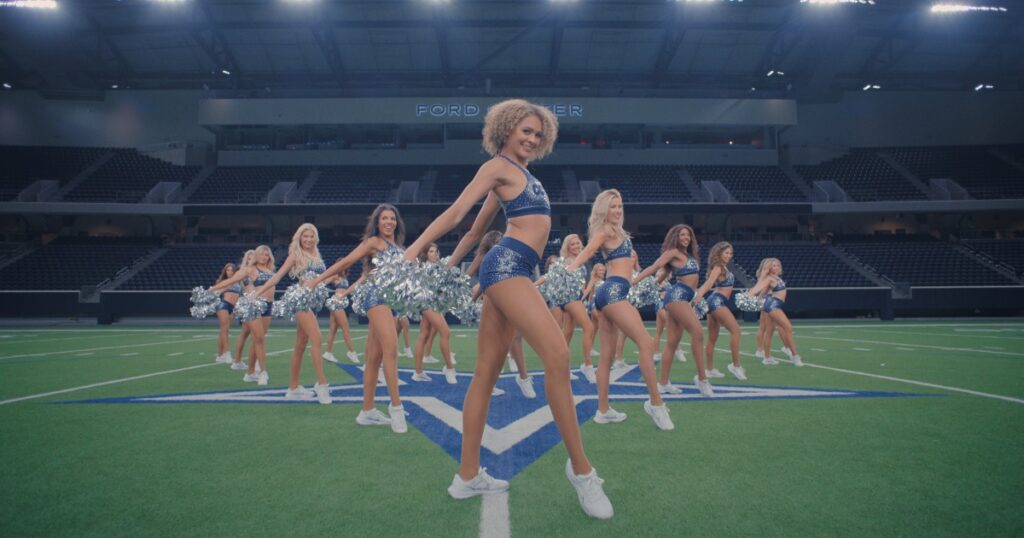

After decades of performing for one of the NFL’s most valuable franchises while earning less-than-glamorous wages, the Dallas Cowboys Cheerleaders have secured a 400% pay raise.
The wage increase is revealed at the conclusion of the second season of “America’s Sweethearts,” the hit Netflix docuseries that follows the iconic team of dancers from auditions to the end of the NFL season.
The series, which debuted its second season Wednesday, chronicled the cheerleaders’ push for better pay, putting a renewed spotlight on compensation issues that have long plagued NFL cheerleading squads.
“We’re pleased, as you’ll see in the series, that the Dallas Cowboys Cheerleaders were happy with the outcome,” Tad Carper, the Cowboys’ senior vice president of communications, said in a statement.
The show does not disclose the new wages taking effect next season, nor does it reveal the cheerleaders’ current wages.
The Cowboys’ statement did not disclose the exact pay amount, and a spokesperson did not immediately respond to a request for comment Wednesday. According to the cheerleaders’ website, they are paid for rehearsals, home games, promo appearances and shows.
Jada McLean, who retired from the squad after having led the effort to secure higher pay, told The New York Times that she made $15 an hour and $500 for each appearance last year, based on experience. After the pay raise, she said, veteran cheerleaders could soon make more than $75 an hour.
McLean did not immediately respond to NBC News’ request for comment.
The massive fan reaction to the Netflix show after its debut last year helped bring a discussion around pay equity to the forefront, with many viewers questioning why the cheerleaders’ salaries were so low.
The Cowboys cheerleaders — along with other NFL cheerleading teams across the country — have continued to face fan scrutiny over the years for their low pay even though they contribute skilled labor and risk injury and are prominent faces of the Cowboys’ brand.
In 2018, former cheerleader Erica Wilkins filed a class action lawsuit against the Cowboys that resulted in a pay increase in 2019, from $8 to $12 per hour and from $200 to $400 per game. Wilkins, who cheered for the Cowboys from 2014 to 2017, claimed in her lawsuit that she sometimes made less than minimum wage and that the cheerleaders were paid less than the Cowboys’ mascot.
The topic of low wages was briefly broached in the first season of the show, when former cheerleader Kat Puryear compared her yearly pay to that of “a Chick-fil-A worker who works full-time.” NFL football players, in contrast, average salaries of millions of dollars a year.
In the last year, several of the dancers who became Season One fan favorites were propelled to online fame, allowing them to transition into more lucrative social media influencer careers part-time. But many of the dancers struggle as they juggle full-time jobs while they are on the squad, a narrative that is further explored in Season Two.
“We got our contracts and probably wrongly assumed that it maybe would have been different, just because of everything that was on TV,” veteran cheerleader Kylie Dickson says on the show. “The world was kind of telling us, ‘Girls, fight for more.’”
Charlotte Jones, the Cowboys’ executive vice president and chief brand officer, also acknowledged the cheerleaders’ pay, noting that it has drawn criticism before.
“There’s a lot of cynicism around pay for NFL cheerleaders, as it should be,” Jones says in an episode of the show. “They’re not paid a lot. But the facts are they actually don’t come here for the money. They come here for something that’s actually bigger than that to them.”
Kelli Finglass and Judy Trammell, the cheerleaders’ director and head choreographer, respectively, have said on the show that the fact that the dancers have outside careers is what helps make them even more special.
Throughout the second season, team members use the momentum from the show’s buzz to their advantage. They decide to push for better pay for the entire team and meet with franchise staff members before the season begins. But as the season begins, the conversation is tabled, and several of the dancers express their disappointment when their contract for the 2024-25 season includes no pay raise.
It is not until the finale when cheerleader Megan McElaney says the team has finally been granted raises for the coming season — a change that solidified her decision to try out for another year.
“Dancers are athletes. They have so much value,” McElaney says, later adding that the news of the raises felt “kind of felt like a relief, like everything had paid off.”
“Finally, we were done fighting.”
 Latest Breaking News Online News Portal
Latest Breaking News Online News Portal






